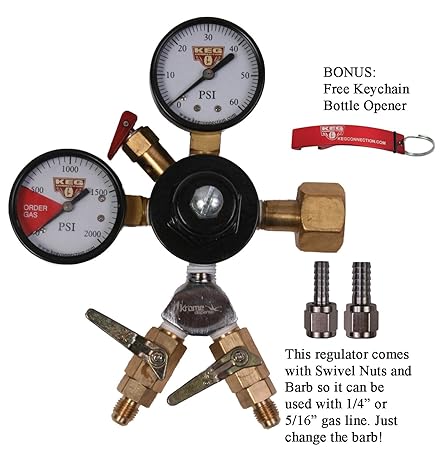So far this is what I have:
- 2 pin lock corny kegs I bought when I started brewing assuming I was going to keg, but haven't for the two years I've been brewing, but now I'm ready. And I got them for ~$25, so I got them before prices have climbed.
- Danby DAR440BL I bought on Craigslist for $70. Brand new, but back corner is dented (oh well). I've seen guides on the conversions on this exact one, so I think I'm good on the conversion.
Here's what I still need and the questions:
- Thinking of buying the Double Faucet Stainless Draft Beer Tower w/ Perlick 525SS Stainless Faucets. It looks like I want SS tower and Perlick 525SS faucets seem to be well liked on here. The flow control ones seem intriguing, but since they aren't SS, I'm thinking I'll stick with the 525SS. Any comments on that?
- Regulator - At first I thought I wanted a dual regulator so I could set the pressure separately on each of the 2 kegs, but in researching, it seems that's not critical. I will most likely only have pale ales, IPAs, porters, stouts in there. Nothing that would require wildly different pressures. Any reason I should get a dual regulator or am I good a single regulator that splits off to each keg? Any recommendations?
- CO2 - I may just buy whatever my LHBS has because I can get 10% off. If not, I may just get the $70 5 lb new aluminum tank on Amazon. Any reason to get new over used? Is 5 lb good enough? I'm not even sure the 10 lb would fit in my fridge.
- All the connections and tubing I'll probably get at my LHBS.
Anything else I'm missing?
- 2 pin lock corny kegs I bought when I started brewing assuming I was going to keg, but haven't for the two years I've been brewing, but now I'm ready. And I got them for ~$25, so I got them before prices have climbed.
- Danby DAR440BL I bought on Craigslist for $70. Brand new, but back corner is dented (oh well). I've seen guides on the conversions on this exact one, so I think I'm good on the conversion.
Here's what I still need and the questions:
- Thinking of buying the Double Faucet Stainless Draft Beer Tower w/ Perlick 525SS Stainless Faucets. It looks like I want SS tower and Perlick 525SS faucets seem to be well liked on here. The flow control ones seem intriguing, but since they aren't SS, I'm thinking I'll stick with the 525SS. Any comments on that?
- Regulator - At first I thought I wanted a dual regulator so I could set the pressure separately on each of the 2 kegs, but in researching, it seems that's not critical. I will most likely only have pale ales, IPAs, porters, stouts in there. Nothing that would require wildly different pressures. Any reason I should get a dual regulator or am I good a single regulator that splits off to each keg? Any recommendations?
- CO2 - I may just buy whatever my LHBS has because I can get 10% off. If not, I may just get the $70 5 lb new aluminum tank on Amazon. Any reason to get new over used? Is 5 lb good enough? I'm not even sure the 10 lb would fit in my fridge.
- All the connections and tubing I'll probably get at my LHBS.
Anything else I'm missing?
Last edited by a moderator:





